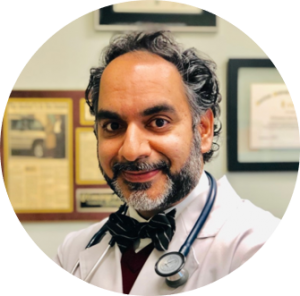How to Best Care for Your Patients When They Are Not Physically in Front of You

M. Samir Qamar, MD, CEO of MedWand
As many doctors do, I often receive medical calls from friends and family. It was one such call that changed my life. My sister, at the time living in Chicago, called my cell and complained of a bad cough. I remember telling her, “What can I do, I can’t even listen to your lungs!”- a frustration that carried over from my own telemedicine experiences where I couldn’t examine patients remotely.
Then, an idea dawned on me — what if we could use the phone’s mic to pick up breath sounds? I asked her to seal the bottom of her cell phone against her bare upper chest and take a few breaths — when she complied, I could hear her lung sounds!
In that moment I had an epiphany: Patients could be examined through their computers or smartphones, and doctors would finally be able to examine patients remotely, something that was always missing in mainstream telemedicine. A week later I called Bob Rose, a master engineer and now the COO for MedWand, to ask him if he wanted to team up and create something extraordinary — and MedWand was born.
Telehealth Should Replicate the Four Components of the Doctor’s Visit
At the very least, the perfect telehealth system must replicate the four components of the doctor’s visit — communication, examination, testing, and treatment delivery.
Communication is when the patient relays relevant history to the doctor. Examination is next, where the doctor physically examines the patient using a stethoscope, otoscope, or other diagnostic tool. Obtaining vital signs such as temperature, heart rate, and oxygen levels are part of this examination process. Testing includes assessments such as EKGs, spirometry, and blood analysis. Finally, treatment delivery is the prescribing of medication, therapy, or referrals to other clinicians.
The telemedicine industry, still in its infancy, has been predominantly stuck in the “communication” phase. Very little has been done in other areas, and if so, there is almost no coordination of the other elements to create an all-in-one experience. The perfect telehealth system would be able to offer all the aforementioned elements under one roof as a basic first step.
How Telehealth can create opportunities or benefits that traditional in-office visits cannot provide
- Accept that there are challenges — First and foremost, it’s important to acknowledge that telemedicine will have limitations. Knowing this going into the visit allows the clinician to think of ways to overcome those limitations as they arise. This mindset is important for risk management and patient safety. Understanding limitations will ultimately lead to solutions, whether during the visit, or for the industry as a whole.
- Ensure optimal communication — On a micro level, patients should make sure there is good connectivity. Clinicians should make efforts to see more than the patient’s head. Asking a patient to sit a little farther back can make a big difference, as can changing the angle on the patient’s camera. Looking at the camera when speaking allows the patient to feel that the clinician is looking at him or her, important for rapport. Good lighting to illuminate facial expressions is also important. On a macro level, there should be strong online connectivity and communication equipment on both sides of the visit, clinician and patient. Improvements with satellite networks, faster connection speeds, and better cameras will make a big difference in the future.
- Incorporate remote testing — In the present, we should try implementing testing methods that already exist. Online, patients can take their temperature or blood pressure with their own equipment. For labs, they can ask for referrals to labs, or even order specific tests via commercially available home testing kits. In the future, I believe testing technology will improve dramatically, allowing patients to use integrated biosensors to collect and send data for medical analysis whenever needed.
- Incorporate trustworthy telemedicine diagnostic devices — Physical exams are a necessary component of standard medical practice, whether in person or via telemedicine, and methods should be sought out to do so. Currently, very few telemedicine examination devices exist, and the ones that do are either limited in functionality, or inaccurate. The patient’s own camera serves as a powerful visualization tool now, but more data is needed for medical visits.
- Care for patients as though they were in front of you — It may seem obvious but remembering that patients on screen are real individuals with real medical needs is important. While every clinician’s style varies, all patients want to feel cared for and expect basic health services. Empathy, politeness, and competency can all be conveyed online. Telemedicine devices like MedWand, in fact, contribute to building rapport — patients feel connected to their doctor, for instance, when their heart is listened to or when their throat is examined. A patient will be more loyal to the clinician who cares and provides better medical service — whether via telemedicine, or in person.
Care from anywhere, anytime
One of the consequences of the pandemic is the dramatic growth of Telehealth and Telemedicine. I believe that advanced telemedicine will eventually replace much of what we see in the clinical world today. My team and I want doctors to have the ability to examine patients anywhere in the world, and patients to have the ability to receive care anywhere as well. That’s the future of telemedicine.

